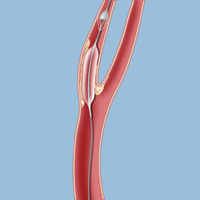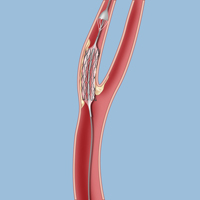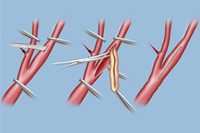The goal of surgery for carotid occlusive disease is to restore good blood flow to the brain (either by reopening the artery to a healthy width or removing the blockage that’s preventing blood flow) and to eliminate plaque that can break free to go into the brain's blood vessels and cause a stroke. Patients diagnosed with carotid stenosis should be evaluated by a neurosurgeon to determine the most effective course of surgical treatment. Surgery is sometimes performed on an emergency basis, when the patient has had a stroke and the blockage must be removed immediately.
Options for surgical treatment include angioplasty/stenting and endarterectomy, which may be used in combination to treat an occlusion.

Carotid angioplasty for carotid occlusive disease
Carotid angioplasty, also called balloon angioplasty, is a minimally invasive procedure in which a small catheter is inserted into an artery in the groin or wrist and threaded up to the carotid artery. A tiny balloon on the tip of the catheter is then inflated, widening the artery at the spot where it’s narrowed or blocked.
Angioplasty is also used to place a stent in the artery.

Carotid stenting for carotid occlusive disease
Carotid artery stenting involves the placement of a small self-expanding stent (tube) inside the narrowed artery. The wire-mesh stent is threaded up to the carotid artery from the groin, and is expanded once it reaches the blockage. The stent holds the carotid artery open to a sufficient width to allow good blood flow to the brain. A stent is usually placed as part of a carotid angioplasty.

Carotid endarterectomy for carotid occlusive disease
Whichever procedure is deemed appropriate, it should be performed in a major medical center with highly experienced neurosurgeons. Use our online form to request an appointment for evaluation or second opinion, or set up a secure online account where you may upload images for a second opinion.
Reviewed by Philip E. Stieg, Ph.D., M.D.
Last reviewed/last updated: October 2023
Illustrations by Thom Graves, CMI